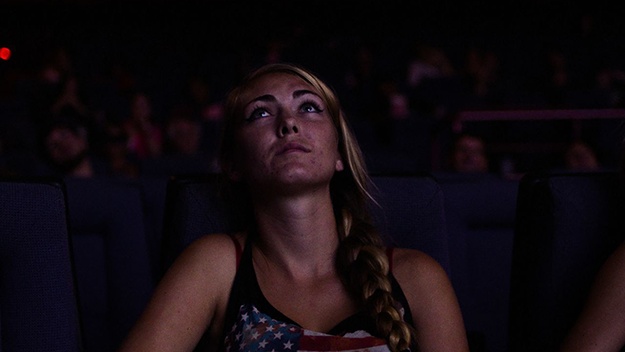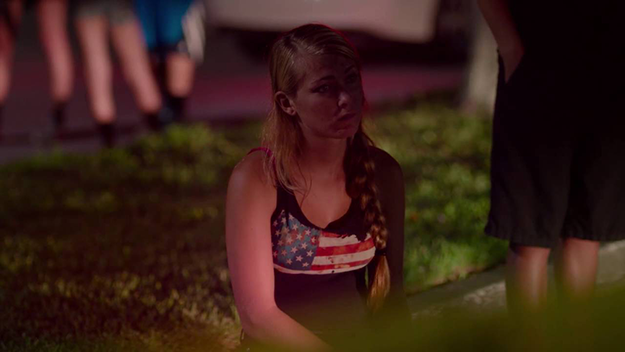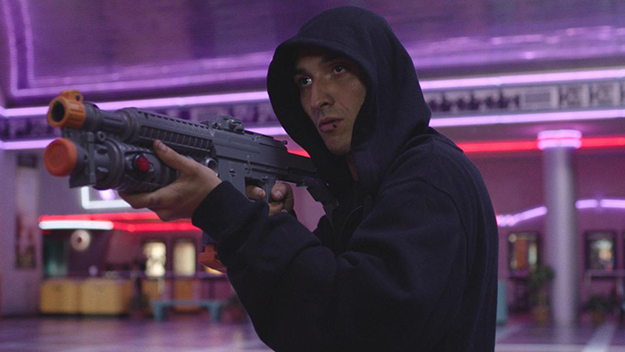A half-dozen people in Sarasota, Florida go through the daily motions of their lives before they enter the site of a midnight movie-house slaughter in Tim Sutton’s luminous, self-destructive Dark Night. Sutton must think American suburbia serves simply as an active incubation chamber for atrocities like the 2012 mass shooting at a multiplex in Aurora, Colorado during a midnight show of The Dark Knight Rises. Sutton, who lives in Brooklyn, recently said on the Criterion Collection website: “I was looking for a very generic America” and that he first intended to shoot “in a series of strip malls and parking lots.” He explained: “I went down to Florida to see if I connected with the landscape, and I did, because Florida’s one of those places where you’re looking at the ocean and it’s beautiful and you turn around and you’re in the biggest parking lot you’ve ever seen in your life. But the thing that really got me connected was the Spanish moss. I don’t focus on it at all in the movie, but you go down there and there’s this feeling of death hanging from the trees.” I’m glad he didn’t zero in on the foliage. Spanish moss conjuring “this feeling of death hanging from the trees” has been a Southern Gothic cliché for centuries. (Walt Whitman had a more piquant idea: he wrote that when he wrapped some Spanish moss around an oak twig it made him think of “manly love.”) Underneath Sutton’s stylish craftsmanship, the movie feeds on moldy ideas of youthful disconnection and epidemic narcissism. Dark Night comes on like an exploration of alienation in suburbs devoid of community, where big-box stores and ailing malls substitute for old town squares, guns are close at hand, and adolescents carve their own worlds out of thin air as they lose themselves in videogames or colonize the Internet or vault skyward on skateboards. But Dark Night doesn’t feel like an open-ended investigation. It’s more like a closed case. Sutton and his prodigiously gifted cinematographer Hélène Louvart (Pina, The Wonders, The Beaches of Agnes) conjure visual wonders from the start. Dark Night begins with extreme close-ups of a shooting survivor’s right eye as it reflects the flicker of red, white, and blue police lights. When the camera pulls away we see that she’s wearing a black tank top emblazoned with an American flag. These images are devastatingly obvious, but they’re also beautiful. Sutton follows them with an aerial view of two Sarasota housing developments, the roofs and yards laid out in an impersonal symmetry, as if created by a demigod afflicted with OCD. Sutton might as well be rendering the imagistic equivalent of that old anti-suburbia anthem, “Little Boxes (on the Hillside),” which a real satirist, Tom Lehrer, once called “the most sanctimonious song ever written.” For the score of Dark Night, Sutton relies on the breathy, drowsy, morose musical stylings of Canadian singer-songwriter Maica Armata. I assume that her climactic reprise of “You Are My Sunshine” is meant to be searing and ironic. I found it inadvertently funny.
Dark Night is an extraordinarily accomplished mood piece saddled with a shallow condemnation of middle-American culture. The whole movie is like an extended art-house PSA. The most dangerous character in it is a boy-man with piercing eyes who never looks more genuine than when he’s lying down on his couch, staring upward. Even when he’s at his most sour and lowdown, he can drive down the road from his own modest pad and stroll into an upper-middle-class palace, where he grabs some milk and cookies and accepts money from the woman of the house (his mom? an aunt? a friend’s mom? We don’t know). Sutton, a rigorous formalist, appears to loathe his characters’ lifestyles for being too formless. An aspiring lingerie model works out incessantly (we hear the commands of her unseen video trainer), takes selfies in her scanties, and phones a potential employer while pretending to be her own agent. A former combat engineer goes to a support group, comes home to clean his firearms, and later takes a little boy (his wife or girlfriend’s and presumably his own) to the movies (you can guess which show). A Hispanic shopgirl at a big-box store goes swimming with a crowd of Anglos and subsequently mimics a blonde girl’s tattoo-like eye makeup. (It’s the same pattern sported by the survivor at the beginning of the movie.) She goes to the movies with a pudgy co-worker who at first seems pathetic. We soon see that she has more life than anyone else in Dark Night. En route to the theater this pal takes off her big glasses and puts on her superhero mask. The film’s most poignant moment comes when she says, “This is going to be amazing.” All that unites these bits and piece is an underlying mood of frustration. Sutton is tactful with his nonprofessional cast. He resists showing any carnage; the only gore we see comes when a skateboarder bloodies a finger. Still, the film’s use of an Aurora-like massacre as a topical peg feels unearned and opportunistic: Sutton divides his characters equally between men and boys who could be killers (or accomplices), and women and girls who are almost certainly victims. Will the shooter turn out to be the skateboarder who gets his hair dyed orange like Aurora shooter James Holmes, or the moody video-games aficionado who occasionally hallucinates and has some kind of love-hate for his pet turtle? Even after you learn the killer’s identity, you wonder if any other malaise-ridden characters will become part of his plot. At its worst, Dark Night toys with our expectations in the high-end aesthetic manner of Gus Van Sant’s exasperating Columbine doodle Elephant. That cheap tension does, though, keep you watching; Sutton’s hypnotic visual artistry at times makes it worthwhile. And some of his effects are mesmerizing: two friends skateboarding in tandem pull in front of each other—and in and out of a traveling shot—with musical regularity. A purple-tinted car window bisects a view of trees and sky; we later realize it’s the view from the killer’s sunroof.
Despite its ambitious fusion of art-film and documentary techniques, the film feels incomplete, like an unfinished tapestry. Sutton disclosed part of his method to rogerebert.com a year ago, after the film’s premiere at Sundance: “I wanted a vet; I wanted a selfie freak; I wanted a young Latina who wants something else; I wanted a troubled teenager. I tried to design these types and meet these people, and specify what they would be. They are themselves 100%. Eddie, the vet, those are his guns. That is his range. That is his support group. That’s all real.” But how real are they as a reflection of a community? How much could Sutton discover about the roots of American volatility and discontent if he had his cast of characters and lines of action plotted out beforehand? Dark Night gives us neither the emotional satisfaction of drama nor the revelatory power of documentary. Its blending of factual and fictional styles, as well as the beauty of the skateboarding scenes, remind me of Baltimore filmmaker Matt Porterfield’s Putty Hill. But watching Porterfield’s movie, we never doubt that we’re getting a slice of genuine regional experience. Dark Night, by comparison, is a work of aesthetic tourism. Remember the tagline for Easy Rider? “They went looking for America and couldn’t find it anywhere.” I had the feeling Sutton could go looking for America and find it anywhere, because he already had it in his head. Michael Sragow is a contributing editor to Film Comment and writes its Deep Focus column. He is a member of the National Society of Film Critics and the Los Angeles Film Critics Association. He also curates “The Moviegoer” at the Library of America website.


